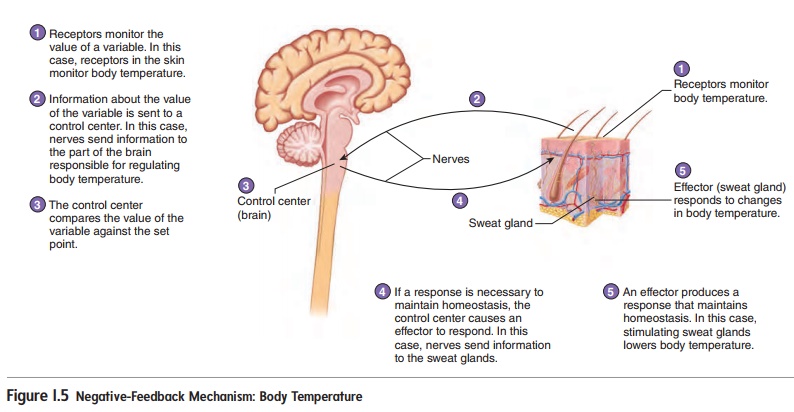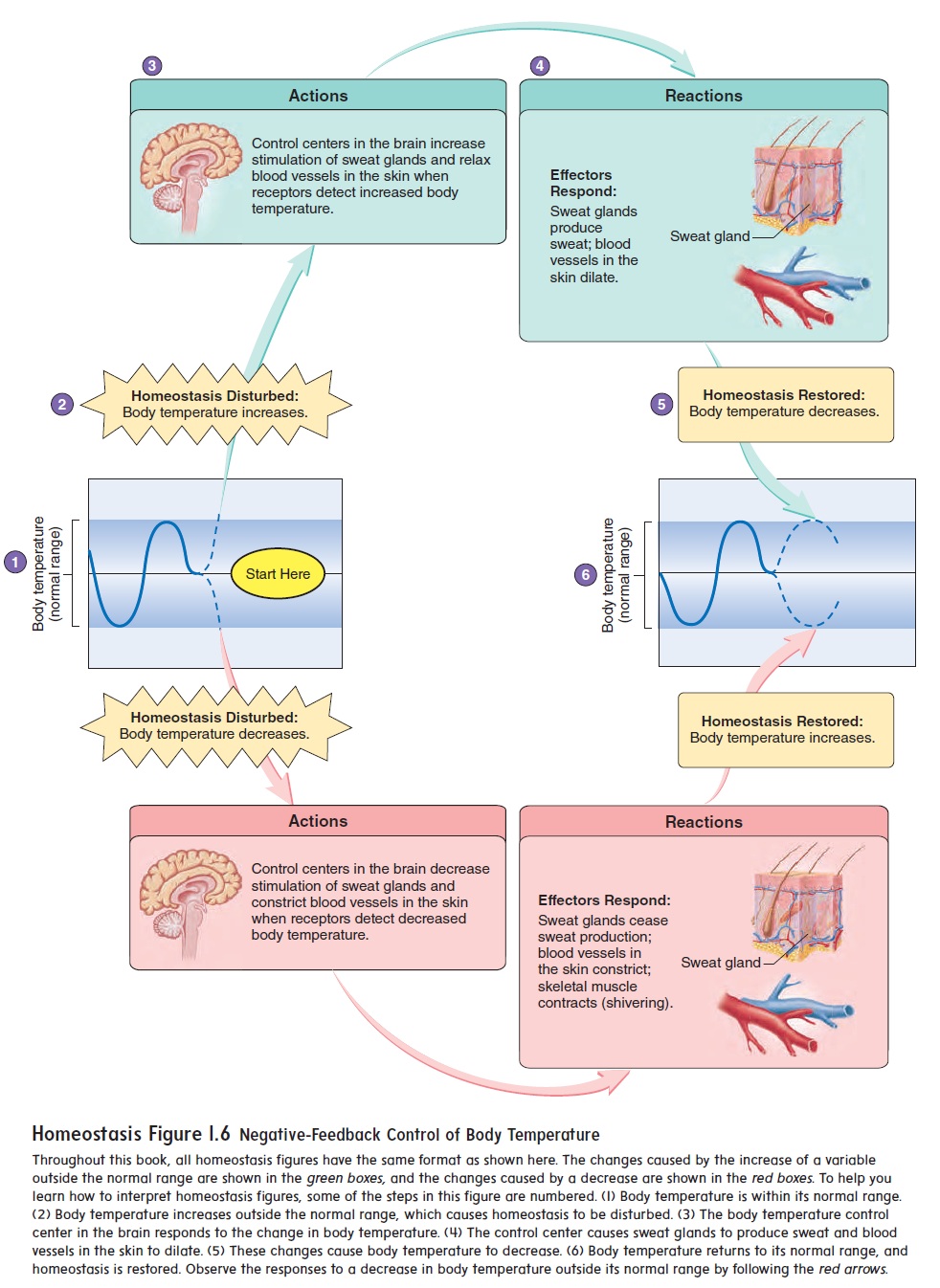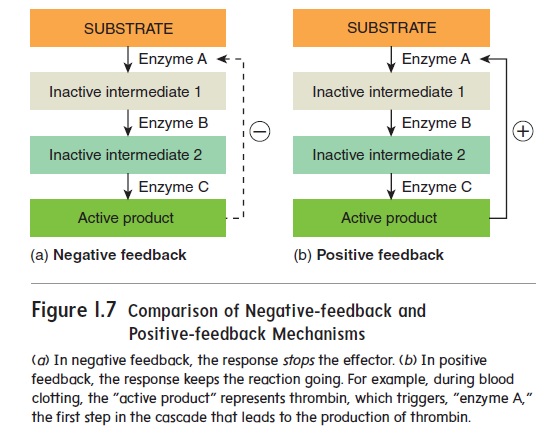Chapter: Essentials of Anatomy and Physiology: The Human Organism
Homeostasis

HOMEOSTASIS
A. Define homeostasis, and explain why it is important for proper body function.
B. Describe a negative-feedback mechanism and give an example.
C. Describe a positive-feedback mechanism and give an example.
Homeostasis (h̄o′m̄e-̄o-st̄a′sis;homeo-,the same) is the existenceand maintenance of a relatively constant environment within the body despite fluctuations in either the external environment or the internal environment. Most body cells are surrounded by a small amount of fluid, and normal cell functions depend on the mainte-nance of the cells’ fluid environment within a narrow range of con-ditions, including temperature, volume, and chemical content. These conditions are called variables because their values can change. For example, body temperature is a variable that can increase in a hot environment or decrease in a cold environment.
Homeostasis is the maintenance of a variable, such as body temperature, around an ideal normal value, or set point. The value of the variable fluctuates around the set point to establish a normal range of values.
Homeostatic mechanisms, such as sweating or shivering,normally maintain body temperature near an ideal normal value, or set point (figure 1.4). Most homeostatic mechanisms are gov-erned by the nervous system or the endocrine system. Note that homeostatic mechanisms are not able to maintain body temperature precisely at the set point. Instead, body temperature increases anddecreases slightly around the set point, producing a normal range of values. As long as body \temperatures remain within this normal range, homeostasis is \maintained.

The organ systems help control the internal environment so that it remains relatively constant. For example, the digestive, respiratory, cardiovascular, and urinary systems function together so that each cell in the body receives adequate oxygen and nutri-ents and so that waste products do not accumulate to a toxic level. If the fluid surrounding cells deviates from homeostasis, the cells do not function normally and may even die. Disease disrupts homeostasis and sometimes results in death. Modern medicine attempts to understand disturbances in homeostasis and works to reestablish a normal range of values.
Negative Feedback
Most systems of the body are regulated by negative-feedbackmechanisms, which maintain homeostasis.Negativemeans thatany deviation from the set point is made smaller or is resisted. Negative feedback does not prevent variation but maintains varia-tion within a normal range.
The maintenance of normal body temperature is an example of a negative-feedback mechanism. Normal body temperature is important because it allows molecules and enzymes to keep their normal shape so they can function optimally. An optimal body temperature prevents molecules from being permanently destroyed. Picture the change in appearance of egg whites as they are cooked; a similar phenomenon can happen to molecules in our body if the temperature becomes too high. Thus, normal body temperature is required to ensure that tissue homeostasis is maintained.
Many negative-feedback mechanisms, such as the one thatmaintains normal body temperature, have three components: (1) A ′tŏr, rē- such as body temperature; (2) a control center, such as part of the brain, establishes the set point around which the variable is maintained; and (3) an effector (ē-fek′tŏr), such as the sweat glands, can change the value of the variable. A changed variable is a stimulus because it initiates a homeostatic mechanism.

Normal body temperature depends on the coordination of multiple structures, which are regulated by the control center, or hypothalamus, in the brain. If body temperature rises, sweat glands (the effectors) produce sweat and the body cools. If body temperature falls, sweat glands do not produce sweat (figure 1.5). The stepwise process that regulates body temperature involves the interaction of receptors, the control center, and effectors. Often, there is more than one effector and the control center must integrate them. In the case of elevated body temperature, thermoreceptors in the skin and hypothalamus detect the increase in temperature and send the information to the hypothalamus con-trol center. In turn, the hypothalamus stimulates blood vessels in the skin to relax and sweat glands to produce sweat, which sends more blood to the body’s surface for radiation of heat away from the body. The sweat glands and skin blood vessels are the effec-tors in this scenario. Once body temperature returns to normal, the control center signals the sweat glands to reduce sweat pro-duction and the blood vessels constrict to their normal diameter. On the other hand, if body temperature drops, the control center does not stimulate the sweat glands. Instead, the skin blood ves-sels constrict more than normal and blood is directed to deeper regions of the body, conserving heat in the interior of the body. In addition, the hypothalamus stimulates shivering, quick cycles of skeletal muscle contractions, which generates a great amount of heat. Again, once the body temperature returns to normal, the effectors stop. In both cases, the effectors do not produce their responses indefinitely and are controlled by negative feedback. Negative feedback acts to return the variable to its normal range (figure 1.6).

Positive Feedback
Positive-feedback mechanisms occur when the initial stimulusfurther stimulates the response. In other words, the deviation from the set point becomes even greater. At times, this type of response is required to re-achieve homeostasis. For example, during blood loss, a chemical responsible for clot formation stimulates production of itself. In this way, a disruption in homeo-stasis is resolved through a positive-feedback mechanism. What prevents the entire vascular system from clotting? The clot forma-tion process is self-limiting. Eventually, the components needed to form a clot will be depleted in the damaged area and more clot material cannot be formed (figure 1.7).
Birth is another example of a normally occurring positive-feedback mechanism. Near the end of pregnancy, the uterus is stretched by the baby’s large size. This stretching, especially around the opening of the uterine muscles. The uterine contractions push the baby against the opening of the uterus, stretching it further. This stimulates additional contractions, which result in additional stretching. This positive-feedback sequence ends when the baby is delivered from the uterus and the stretching stimulus is eliminated.

On the other hand, occasionally a positive-feedback mecha-nism can be detrimental. One example of a detrimental positive-feedback mechanism is inadequate delivery of blood to cardiac (heart) muscle. Contraction of cardiac muscle generates blood pres-sure and moves blood through the blood vessels to the tissues. A system of blood vessels on the outside of the heart provides cardiac muscle with a blood supply sufficient to allow normal contractions to occur. In effect, the heart pumps blood to itself. Just as with other tissues, blood pressure must be maintained to ensure adequate delivery of blood to the cardiac muscle. Following extreme blood loss, blood pressure decreases to the point that the delivery of blood to cardiac muscle is inadequate. As a result, cardiac muscle homeo-stasis is disrupted, and cardiac muscle does not function normally. The heart pumps less blood, which causes the blood pressure to drop even lower. The additional decrease in blood pressure further reduces blood delivery to cardiac muscle, and the heart pumps even less blood, which again decreases the blood pressure. The process continues until the blood pressure is too low to sustain the cardiac muscle, the heart stops beating, and death results.
Following a moderate amount of blood loss (e.g., after donating a pint of blood), negative-feedback mechanisms result in an increase in heart rate that restores blood pressure. However, if blood loss is severe, negative-feedback mechanisms may not be able to maintain homeostasis, and the positive-feedback effect of an ever-decreasing blood pressure can develop.
A basic principle to remember is that many disease states result from the failure of negative-feedback mechanisms to main-tain homeostasis. The purpose of medical therapy is to overcome illness by aiding negative-feedback mechanisms. For example, a transfusion can reverse a constantly decreasing blood pressure and restore homeostasis.
Related Topics